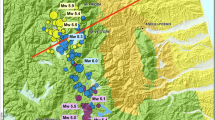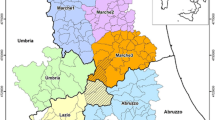Abstract
A general methodological approach is here discussed to integrate geological and geophysical information in seismic microzonation studies. In particular, the methodology aims at maximizing the exploitation of low-cost data for an extensive preliminary assessment of ground motion amplification phenomena induced by the local seismo-stratigraphical configuration. Three main steps are delineated: (a) the combination of geological/geomorphological analyses to develop an Engineering-Geological Model of the study area; (b) targeted geophysical prospecting to provide an Engineering-Geological/Geophysical Model; (c) evaluating effectiveness of Engineering-Geological/Geophysical Model by estimating expected ground motion amplification phenomena by the use of suitable computational tools. The workflow is illustrated by a case-study based on a set of villages in the Umbro-Marchean Apennine (Central Italy) damaged during the Seismic sequence that occurred in Central Italy during 2016–2017.











Similar content being viewed by others
References
Albarello D (2017) Extensive application of seismic microzoning: methodological and socio-political issues in the Italian Experience. Boll Geofis Teor Appl 58(4):253–264. https://doi.org/10.4430/bgta0205
Albarello D, Cesi C, Eulilli V, Guerrini F, Lunedei E, Paolucci E, Pileggi D, Puzzilli LM (2011) The contribution of the ambient vibration prospecting in seismic microzoning: an example from the area damaged by the 26th April 2009 L’Aquila (Italy) earthquake. Boll Geofis Teor Appl 52:513–538. https://doi.org/10.4430/bgta0013
Albarello D, Socco LV, Picozzi M, Foti S (2015) Seismic Hazard and land management policies in Italy: the role of seismic investigations. First Break 33:87–93. https://doi.org/10.3997/1365-2397.33.8.82009
Albarello D, Francescone M, Lunedei E, Paolucci E, Papasidero MP, Peruzzi G, Pieruccini P (2017) Seismic characterization and reconstruction of reference ground motion at accelerometric sites of the Italian national accelerometric network (RAN). Nat Hazards 86:401–416. https://doi.org/10.1007/s11069-016-2310-4
Amanti M, Chiessi V, Muraro C, Puzzilli LM, Roma M, Catalano S, Romagnoli G, Tortorici G, Cavuoto G, Albarello D, Fantozzi PL, Paolucci E, Pieruccini P, Caprari P, Mirabella F, Della Seta M, Esposito C, Di Curzio D, Francescone M, Pizzi A, Macerola L, Nocentini M, Tallini M (2020) Geological and geotechnical models definition for 3rd level seismic microzonation studies in Central Italy. Bull Earthq Eng 18:5441–5473. https://doi.org/10.1007/s10518-020-00843-x
Arai H, Tokimatsu K (2005) S-wave velocity profiling by joint inversion of microtremor dispersion curve and horizontal-to-vertical (H/V) spectrum. Bull Seismol Soc Am 95(5):1766–1778. https://doi.org/10.1785/0120040243
Ashford SA, Sitar N (1997) Analysis of topographic amplification of inclined shear waves in a steep coastal bluff. Bull Seismol Soc Am 87:692–700
ASTM (2017) Standard Practice for Classification of Soils for Engineering Purposes (Unified Soil Classification System), ASTM International, West Conshohocken, PA, www.astm.org
Various Authors (2011) Contributi per l’aggiornamento degli ‘‘Indirizzi e criteri per la microzonazione sismica’’, in: Ingegneria Sismica, 28, 2, Patron editore, Bologna, Italy (in Italian), http://www.protezionecivile.gov.it/resources/cms/documents/aggiornamento_indirizzi_microzonazione_sismica.pdf
Baratta M (1910) La catastrofe sismica calabro messinese: 28 dicembre 1908. Società geografica italiana, reprinted by Forni, 1985, Bologna (in Italian)
Bard PY (1999) Microtremor measurements: a tool for site effect estimation? In: Irikura K, Kudo K, Okada H, Sasatani T (eds) The effects of surface geology on seismic motion. Balkema, Rotterdam, pp 1251–1279
Bigi S, Cantalamessa G, Centamore E, Didaskalou P, Micarelli A, Nisio S, Pennesi T, Potetti M (1997) The periadriatic basin (Marche-Abruzzi sector, Central Italy) during the Plio-Pleistocene. Giorn Geol 59:245–259
Boccaletti M, Calamita F, Deiana G, Gelati R, Massari F, Moratti G, Ricci Lucchi F (1990) Migrating foredeep-thrust belt system in the Northern Apennines and Southern Alps. Paleo Paleo Paleo 77:3–14. https://doi.org/10.1016/0031-0182(90)90095-O
Bonnefoy-Claudet S, Cotton F, Bard PY (2006) The nature of noise wavefield and its applications for site effects studies: a literature review. Earth Sci Rev 9:205–227. https://doi.org/10.1016/j.earscirev.2006.07.004
BSSC NEHRP (2000) Recommended provisions for seismic regulations for new buildings and other structures. 2000 Edition, Building Seismic Safety Council for the Federal Emergency Management Agency (FEMA Rep. 368, 369), Part 1: Provisions (FEMA Report 368); Part 2: Commentary (FEMA Report 369), Washington, D.C
Caielli G, De Franco R, Di Fiore V, Albarello D, Catalano S, Pergalani F, Cavuoto G, Cercato M, Compagnoni M, Facciorusso J, Famiani D, Ferri F, Imposa S, Martini G, Paciello A, Paolucci E, Passeri F, Piscitelli S, Puzzilli LM, Vassallo M (2020) Extensive surface geophysical prospecting for seismic microzonation. Bull Earthq Eng 18:5475–5502. https://doi.org/10.1007/s10518-020-00866-4
Calamita F, Deiana G (1988) The arcuate shape of the Umbria-Marche-Sabina Apennines (Central Italy). Tectonophysics 146:139–147. https://doi.org/10.1016/0040-1951(88)90087-X
Calamita F, Coltorti M, Pieruccini P, Pizzi A (1999) Evoluzione strutturale e morfogenesi plio-quaternaria dell’Appennino umbro-marchigiano tra il pedappennino umbro e la costa adriatica. Boll Soc Geol It 118:125–139 (in Italian)
Cavazza W, Roure F, Ziegler PA (2004) The Mediterranean area and the surrounding regions: active processes, remnants of former Tethyan oceans and related thrust belts. In: Cavazza W, Roure F, Spakman W, Stampf GM, Ziegler PA (eds) The Transmed Atlas The Mediterranean Region from crust to mantle. Springer, Berlin, pp 1–29
Centamore E, Deiana G, Micarelli A, Potetti M (1986) Il Trias-Paleogene delle Marche. In: Centamore E, Deiana G (eds) La Geologia delle Marche. Studi Geol, Camerti, pp 9–27 ((in Italian))
Centamore E, Cantalamessa G, Micarelli A, Potetti M, Berti D, Bigi S, Morelli C, Ridolfi M (1991) Stratigrafia ed analisi di facies dei depositi del Miocene e del Pliocene inferiore dell’avanfossa marchigiano-abruzzese e delle avanfosse limitrofe. Studi Geol Camerti, Vol. Spec. 1991/2, 125–132 (in Italian)
Ciancimino A, Lanzo G, Alleanza GA, Amoroso S, Bardotti R, Biondi G, Cascone E, Castelli F, Di Giulio A, D’Onofrio A, Foti S, Lentini V, Madiai C, Vessia G (2020) Dynamic characterization of fine-grained soils in Central Italy by laboratory testing. Bull Earthq Eng 18:5503–5531. https://doi.org/10.1007/s10518-019-00611-6
Coltorti M, Pieruccini P (1999) A late Lower Pliocene planation surface across the Italian Peninsula: a key tool in neotectonic studies. J Geodyn 29:323–328. https://doi.org/10.1016/S0264-3707(99)00049-6
Cosentino D, Cipollari P, Marsili P, Scrocca D (2010) Geology of the central Apennines: a regional review, In: Beltrando M, Peccerillo A, Mattei M, Conticelli S, Doglioni C (Eds.), J Virtual Explorer, 36, 11. https://doi.org/10.3809/jvirtex.2009.00223
CTMS (Commissione tecnica per la Microzonazione sismica) (2018) Standard di Rappresentazione ed archiviazione informatica, versione 4.1.1, Dept.of Civil Protection, Rome (in Italian), https://www.centromicrozonazionesismica.it/it/download/send/26-standardms-41/71-standardms-4-1
DB-SM (2019) Portale cartografico della Microzonazione Sismica e della Condizione Limite per l’Emergenza, https://www.webms.it/servizi/viewer.php; [accessed, March 2020]
EN 1998-1 (2004) Eurocode 8: Design of structures for earthquake resistance. Part 1: General rules, seismic actions and rules for buildings, Brussels
Faccioli E (ed) (1986) Elementi per una guida alle indagini di microzonazione sismica. Consiglio Nazione delle Ricerche, Rome (in Italian)
Foti S, Parolai S, Albarello D, Picozzi M (2011) Application of surface wave methods for seismic site characterization. Surv Geophys 32(6):777–825. https://doi.org/10.1007/s10712-011-9134-2
Foti S, Hollender F, Garofalo F, Albarello D, Asten M, Bard PY, Comina C, Cornou C, Cox B, Di Giulio G, Forbriger T, Hayashi K, Lunedei E, Martin A, Mercerat D, Ohrnberger M, Poggi V, Renalier F, Sicilia D, Socco V (2017) Guidelines for the good practice of surface wave analysis: a product of the InterPACIFIC project. Bull Earthq Eng 16:2367–2420. https://doi.org/10.1007/s10518-017-0206-7
Galli P, Castenetto S, Peronace E (2017) The macroseismic intensity distribution of the 30 October 2016 earthquake in central Italy (Mw 6.6): seismotectonic implications. Tectonics 36:2179–2191. https://doi.org/10.1002/2017TC004583
García-Jerez A, Piña-Flores J, Sánchez-Sesma FJ, Luzón F, Perton M (2016) A computer code for forward computation and inversion of the H/V spectral ratio under the diffuse field assumption. Comput Geosci 97:67–78. https://doi.org/10.1016/j.cageo.2016.06.016
IAEA (2016) Seismc hazard assessment in site evaluation for nuclear installations: ground motion prediction equations and site response, IAEA-TECDOC-1796, Wien
Kottke AR, Rathje EM (2008) "Technical manual for Strata." Report No.: 2008/10. Pacific Earthquake Engineering Research Center, University of California, Berkeley
Kramer SL (1996) Geotechnical earthquake engineering. Prentice Hall, New Jersey, USA
Lachet C, Bard PY (1994) Numerical and theoretical investigations on the possibilities and limitations of Nakamura’s technique. J Geophys Earth 42:377–397. https://doi.org/10.4294/jpe1952.42.377
Mase LZ, Sugianto N, Refrizon (2021) Seismic hazard microzonation of Bengkulu City, Indonesia. Geoenviron Disasters 8:5. https://doi.org/10.1186/s40677-021-00178-y
Medvedev SV (1965) Engineering Seismology, Israel Program fo Scientific Translations Ltd., Jerusalem
Molnar S, Assaf J, Sirohey A, Adhikari SR (2020) Overview of local site effects and seismic microzonation mapping in Metropolitan Vancouver, British Columbia, Canada. Eng Geol 270:105568. https://doi.org/10.1016/j.enggeo.2020.105568
Mori F, Gaudiosi I, Tarquini E, Bramerini F, Castenetto S, Naso G, Spina D (2020) HSM: a synthetic damage-constrained seismic hazard parameter. Bull Earthq Eng 18:5631–5654. https://doi.org/10.1007/s10518-019-00677-2
Moscatelli M, Albarello D, Scarascia Mugnozza G, Dolce M (2020) The Italian approach to seismic microzonation. Bull Earthq Eng 18:5425–5440. https://doi.org/10.1007/s10518-020-00856-6
NTC (2018) Norme Tecniche per le Costruzioni. Decreto del Ministero delle Infrastrutture, GU serie generale n.42, 20-02-2018—Suppl. Ordinario n.8
Okada H (2003) The microtremor survey method, geophysical monograph series, 12. Soc Explor Geophys. https://doi.org/10.1190/1.9781560801740
Pagliaroli A, Pergalani F, Ciancimino A, Chiaradonna A, Compagnoni M, De Silva F, Foti S, Giallini S, Lanzo G, Lombardi F, Luzi L, Macerola L, Nocentini M, Pizzi A, Tallini M, Teramo C (2020) Site response analyses for complex geological and morphological conditions: relevant case-histories from 3rd level seismic microzonation in Central Italy. Bull Earthq Eng 18:5741–5777. https://doi.org/10.1007/s10518-019-00610-7
Paolucci R (2002) Amplification of earthquake ground motion by steep topographic irregularities. Earthq Eng Struct Dynam 31:1831–1853. https://doi.org/10.1002/eqe.192
Paolucci E, Tanzini A, Peruzzi G, Albarello D, Tiberi P (2020) Empirical testing of a simplified approach for the estimation of 1D lithostratigraphical amplification factor. Bull Earthq Eng 18:1285–1301. https://doi.org/10.1007/s10518-019-00772-4
Park CB (2011) Imaging dispersion of MASW data-full vs. selective offset scheme. J Environ Eng Geophys 16(1):13–23. https://doi.org/10.2113/JEEG16.1.13
Peruzzi G, Albarello D, Baglione M, D’Intinosante V, Fabbroni P, Pileggi D (2016) Assessing 1D seismic response in microzoning studies in Italy. Bull Earthq Eng 14:373–389. https://doi.org/10.1007/s10518-015-9841-z
Régnier J, Bertrand E, Cadet H (2020) Repeatable process for seismic microzonation using 1-D site-specific response spectra assessment approaches. Application to the city of Nice, France. Eng Geol 270:105569. https://doi.org/10.1016/j.enggeo.2020.105569
Salsabili M, Saeidi A, Rouleau A, Nastev N (2021) Seismic microzonation of a region with complex surficial geology based on different site classification approaches. Geoenviron Disasters. https://doi.org/10.1186/s40677-021-00198-8
Thitimakorn T (2019) Seismic microzonation maps of Phrae city, Northern Thailand. Geomat Nat Haz Risk 10(1):2276–2290. https://doi.org/10.1080/19475705.2019.1693705
WGSM (Working Group on Seismic Microzoning) (2008) Indirizzi e criteri per la microzonazione sismica, Conferenza delle Regioni e delle Province autonome—Dipartimento della Protezione Civile, Rome, 3 vol. and DVD (in Italian), http://www.protezionecivile.gov.it/jcms/it/view_pub.wp?conte ntId=PUB1137, English version at http://www.protezionecivile.gov.it/httpdocs/cms/attach_extra/GuidelinesForSeismicMicrozonation.pdf?
WGSMLA (Working Group on Seismic Microzoning the L’Aquila Area) (2010) Microzonazione sismica per la ricostruzione dell’area aquilana, Regione Abruzzo, Dipartimento della Protezione Civile, 3 vols and DVD, 796 pp. (in Italian), http://www.protezionecivile.gov.it/jcms/it/view_pub.wp?contentId=PUB25330
Acknowledgments
We are grateful to Silvia Marchese, Valerio Ferrazza and Michele Amaddii for their help in performing geophysical and geological/geomorphological surveys in the investigated areas. Vincenzo.Amato and the other anonymous referee also provided encouraging comments and suggestions to improve the paper. The work has been developed in the frame of scientific activity of the Center for Seismic Microzonation and Applications (https://www.centromicrozonazionesismica.it/en/)
Funding
Not applicable.
Author information
Authors and Affiliations
Corresponding author
Ethics declarations
Conflict of interest
The authors declare that they have no conflict of interest.
Additional information
Publisher's Note
Springer Nature remains neutral with regard to jurisdictional claims in published maps and institutional affiliations.
Rights and permissions
About this article
Cite this article
Pieruccini, P., Paolucci, E., Fantozzi, P.L. et al. Developing effective subsoil reference model for seismic microzonation studies: Central Italy case studies. Nat Hazards 112, 451–474 (2022). https://doi.org/10.1007/s11069-021-05188-5
Received:
Accepted:
Published:
Issue Date:
DOI: https://doi.org/10.1007/s11069-021-05188-5




